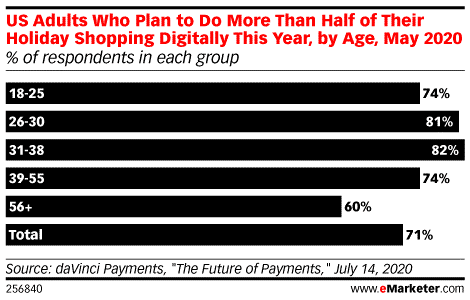As summer turns to autumn, that means the 2020 holiday shopping season can’t be far away. And like everything else this year, it’s going to be different than any we’ve experienced before.
The impact of Covid-19 on ecommerce has been significant since this crisis began. There has been both a surge in traffic and ecommerce revenues as customers have shifted their buying online in an effort to stay safe. It is estimated that ecommerce growth has accelerated by 5 – 10 years in just a short period of time since the pandemic began. This growth coupled with the ongoing crisis will translate into changes for this coming holiday season. Here are our predictions:
Prediction #1 – The Shift Towards Digital Will Continue
Necessitated by the stay-at-home orders last spring, there was a rapid increase in the adoption of ecommerce as many retail stores shut down. According to data from the US Census Bureau of the Department of Commerce, YOY ecommerce sales grew a whopping 45% in the 2nd quarter of 2020. And this level of activity has remained constant even as restrictions were loosened over the summer. It has become apparent that many people who had been resistant to online shopping have overnight jumped into the fray. There’s simply no turning back. Their usage and activity will only increase as move forward.
What Can You Do
- In the short-term, get your existing website ready for the holiday season. That includes making last-minute adjustments to improve site speed, checkout flow, and infrastructure capacity.
- Longer-term, you should evaluate your ecommerce capabilities. Do I have the right staffing in place? Am I making the right investments? Is my ecommerce platform capable of handling this growth and changing requirements?
Prediction #2 – The Holiday Season Will Start Earlier This Year
While the holiday shopping season has been expanding in prior years, this year it will start earlier than ever. Some retailers wait until after Halloween has passed before they begin any holiday promotions. Many will wait until the traditional Thanksgiving weekend to kick off their promotions. However, due to several factors, we predict that the holiday shopping season will begin in early October this year.
First and foremost, is the shift of Amazon Prime Day to October this year. Expected to offer significant deals for consumers, it is anticipated to be the unofficial kickoff to the holiday season. Stoking consumer demand, other retailers will quickly follow up Amazon’s Prime Day with offers and promotions of their own. They’ll seek to capture consumer momentum and offset the drop in Halloween merchandising anticipated to occur as a result of the Covid-19 outbreak this year.
Another factor in extending the holiday season this year are the concerns relating to shipping. With the general surge in ecommerce due to Covid and the anticipated increase as a result of the holiday shopping season, there’s concern that the industry’s capacity to deliver all these orders may be stretched to its limit. Add in the problems occurring at the US Post Office and there’s a good chance shipments will be delayed this year. As a result, extending the season can build some “slack” into the system and help ensure deliveries reach customers in time for the holidays.
What Can You Do
- Prepare your website, promotions, and merchandising so that they are ready in early October.
- Extend your holiday return policies and customer service staffing to cover the earlier start date
- Explore regional delivery carrier options
Prediction #3 – Reduced Emphasis on Black Friday and Cyber 5 Weekend
While still important, the extended holiday season and the anticipated reduction in retail foot traffic this year will reduce the impact of Black Friday and the Cyber 5 (the 5-day period starting Thanksgiving and ending on Cyber Monday) on your overall holiday sales. Home Depot has already announced that they will “reinvent” Black Friday this year to reduce the stress of jamming holiday sales into one frantic weekend. Instead, they will offer Black Friday promotions spanning a two-month period starting in early November.
Another point of note. Many retailers have elected to remain closed on Thanksgiving this year allowing both shoppers and their employees to spend time with their families in light of the circumstances this year including Walmart, Best Buy, Target & Kohl’s.
What Can You Do
- Plan your promotions to start early and continue in earnest until the season is over
- Avoid overt sales promotions on Thanksgiving Day.
Prediction #4 – Supply Chain Issues Will Pose a Problem
The coronavirus not only wreaked havoc on consumers but on supply chains as well. As shoppers were quarantined at home, many factories were either shut down or had trouble staffing to full capacity. In addition, uncertainty surrounding consumer demand and anticipated cash flow led many retailers to curtail their inventory purchasing. Subsequently, high demand gift items may sell out quickly this year and replenishment options may be limited this holiday season.
What Can You Do
- Be proactive in monitoring your sales and inventory levels
- Resort merchandise frequently to avoid out of stock items appearing on category result pages
- Have alternative recommendations for out of stock products
- If possible, switch to local (or onshore) suppliers to reduce procurement time
Prediction #5 – Consumer Behavior Will Continue to Shift as a Result of the Pandemic
Within ecommerce, there have been two profound shifts in customer behavior that have occurred over the course of the pandemic. One of these is the shift to buying online and then picking up in-store (or BOPIS). A similar option is curbside pickup. Both options have allowed consumers to shop online, spending less time in the store, and then having their merchandise available for pickup at their convenience.
A second consumer behavioral change has been the shift in merchandise mix being purchased. As people have stayed at home categories such as travel, high-end apparel and entertainment saw significant sales declines. On the flip side, categories such as wellness, cleaning supplies, home furnishings, and office furniture saw big increases as people invested in their homes.
We believe these shifts will continue this holiday season and into next year.
What Can You Do
- Make investments into your ecommerce platform to support BOPIS and/or curbside pickup
- Follow the trends and where possible shift your product mix to categories in demand
Conclusion
The 2020 holiday shopping season will be unlike any we’ve previously encountered. However, we believe it will continue the positive trend in ecommerce sales that we’ve seen since the beginning of the pandemic. Investing in your online capabilities, responding rapidly to customer data, and delivering a strong customer experience should maximize the benefits to your business this holiday season. And if you find yourself constrained by your systems, platforms, or processes, then there’s no time like the present to invest in the future. Having the agility and flexibility to take advantage of these fast-moving ecommerce trends will be crucial to the future success of your business.

